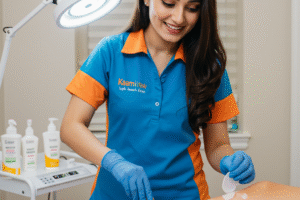Introduction
When it comes to rejuvenating the skin, laser treatments have revolutionized the cosmetic world. But not all lasers are created equal. One of the more recent innovations, the CoolBeam laser, has caught the attention of patients and dermatologists alike. But how exactly does it differ from traditional laser resurfacing methods? That’s what this article is here to explain in a comprehensive, easy-to-follow, and engaging way.
Understanding Laser Skin Resurfacing
laser skin resurfacing before and after has been around for decades. It works by using focused light energy to remove damaged skin layers and stimulate new collagen growth underneath. This process leads to smoother, younger-looking skin, reduced wrinkles, and improved texture.
The most common skin issues treated with laser resurfacing include fine lines, acne scars, sun damage, uneven skin tone, and skin laxity. Despite being highly effective, traditional laser resurfacing can come with extended downtime, discomfort, and certain risks, especially for people with darker skin tones.
This is where modern techniques like the CoolBeam laser have entered the conversation, offering similar or even better results with less disruption to daily life.
What Is the CoolBeam Laser?
CoolBeam is a fractional laser system designed with a focus on both precision and comfort. It uses an advanced CO₂ laser technology but distinguishes itself with its ability to target tiny areas of skin in a fractionated manner. Instead of removing the entire surface layer, CoolBeam creates microscopic zones of injury surrounded by healthy tissue.
This controlled, less invasive approach allows the skin to heal faster while still stimulating deep collagen remodeling. The “cool” in CoolBeam refers not to temperature but to its gentler impact on the skin. It minimizes thermal damage and reduces downtime, which is a significant improvement over earlier laser technologies.
CoolBeam has quickly gained popularity among both providers and patients looking for noticeable results without the intense recovery period associated with older methods.
Traditional Laser Skin Resurfacing: A Closer Look
Traditional laser resurfacing typically uses either ablative or non-ablative lasers. Ablative lasers like the original CO₂ or Erbium lasers physically remove layers of the skin to trigger regeneration. They offer powerful results but often require weeks of downtime due to redness, peeling, and swelling.
Non-ablative lasers, on the other hand, work beneath the skin without removing surface layers. While they involve less recovery time, the results are more subtle and may take several sessions to become visible.
Both techniques have their pros and cons, and choosing the right one depends on your skin type, goals, and willingness to go through the healing process. However, many patients found the intensity of traditional ablative lasers too disruptive, particularly when it came to returning to work or social activities.
Key Differences Between CoolBeam and Traditional Lasers
CoolBeam differs from traditional laser treatments in several important ways. While both aim to improve the skin’s texture, appearance, and youthfulness, their methods of getting there are quite distinct.
Traditional lasers often resurface the skin in a more aggressive, all-over approach. This means the entire surface area is treated, leading to longer healing times and a higher chance of side effects such as prolonged redness or hyperpigmentation.
CoolBeam, on the other hand, uses a fractionated pattern, treating only small columns of skin at a time. The untouched surrounding tissue aids in quicker recovery. It’s like aerating a lawn instead of tearing up the whole yard. The result is fresh, revitalized skin with minimal downtime and discomfort.
Moreover, CoolBeam offers more control over depth and intensity. Dermatologists can customize the settings to suit different skin concerns and skin types, reducing the risk of complications.
CoolBeam’s Unique Impact on Recovery and Results
One of the biggest selling points of CoolBeam laser treatments is the reduced recovery time. Many patients who undergo traditional resurfacing can expect visible peeling and redness that may persist for weeks. This can interfere with daily life, requiring time off work or important events.
With CoolBeam, most people report mild redness and swelling for just a few days. The recovery process is not only quicker but more comfortable. Patients can typically wear makeup within 4 to 5 days and return to normal routines much sooner than they could with more aggressive laser options.
The results, however, are still impressive. Many people notice smoother skin texture, reduction in fine lines, minimized pores, and a more even skin tone within just a few weeks. And because CoolBeam stimulates collagen deep in the dermis, the improvements often continue to develop for months after the treatment.
Safety and Skin Types: Who Benefits More from CoolBeam?
Safety is a major concern when it comes to laser treatments, especially for individuals with darker skin tones. Traditional lasers have historically posed a higher risk of causing hyperpigmentation or uneven skin tone in these patients due to excessive heat and widespread skin disruption.
CoolBeam, with its fractional delivery system, is generally considered safer for a broader range of skin tones. Its ability to leave surrounding tissue untouched supports faster healing and reduces the chance of pigmentation issues. That said, it still requires a professional evaluation before treatment to ensure the settings are tailored correctly for your unique skin profile.
This makes CoolBeam a more inclusive solution in modern skincare. People who were once discouraged from undergoing laser resurfacing due to safety concerns now have a viable and effective option with CoolBeam.
The Patient Experience: Before, During, and After
Preparing for a CoolBeam session starts with a consultation. The provider evaluates your skin, discusses your goals, and sets realistic expectations. Prior to treatment, you might be advised to avoid sun exposure and certain skincare products for a few days.
The procedure itself is generally well-tolerated. A numbing cream is applied to the skin to minimize discomfort. Some patients describe the sensation as a series of light rubber band snaps or a warm tingling feeling. The entire process usually takes 30 to 45 minutes, depending on the area treated.
After treatment, your skin may feel tight and appear red, similar to a mild sunburn. But this usually subsides within a few days. Unlike traditional resurfacing, you’re unlikely to experience intense peeling or oozing. Gentle skincare and sunscreen are essential post-treatment to protect the healing skin and optimize results.
Within a week, most patients already notice a healthier glow. Over the following weeks, the deeper improvements in texture and tone become more apparent. Depending on your skin goals, a series of sessions may be recommended for best results.
Cost Considerations: CoolBeam vs Traditional Lasers
Cost is another factor that often comes into play when choosing between CoolBeam and traditional laser resurfacing. While CoolBeam treatments may be priced similarly to other high-end laser procedures, their value lies in the reduced downtime and fewer sessions required.
Traditional CO₂ resurfacing might offer dramatic results in a single session but often demands a longer healing period and more intensive aftercare. CoolBeam offers a more gradual transformation, making it appealing for people who want to avoid disruptions to their daily routine.
Also, when you factor in the long-term benefits—like collagen production and long-lasting skin rejuvenation—the investment in CoolBeam can be well worth it, especially for those seeking visible change without the hardship of recovery.
Of course, pricing can vary based on the provider’s location, the area treated, and the number of sessions needed. During your consultation, your provider will typically offer a customized quote and treatment plan tailored to your needs.
Final Thoughts on Choosing the Right Laser Treatment
Both CoolBeam and traditional laser resurfacing have their place in the world of skin rejuvenation. The key is understanding your skin’s needs, your lifestyle, and your goals. CoolBeam stands out for its blend of effectiveness and minimal disruption, offering modern patients the best of both worlds: visible results with gentle care.
If you’re someone who wants to freshen up your skin, smooth out fine lines, or boost radiance without pressing pause on your life, CoolBeam might be the perfect solution. However, if you’re looking for a one-and-done dramatic transformation and you’re prepared for the downtime, a traditional CO₂ laser might still be a valid option.
In the end, consultation with an experienced dermatologist or laser specialist is crucial. They can guide you toward the right treatment choice based on your skin type, budget, and expectations. Whether you opt for the modern finesse of CoolBeam or the power of traditional resurfacing, the goal remains the same: helping you feel confident and radiant in your own skin.



